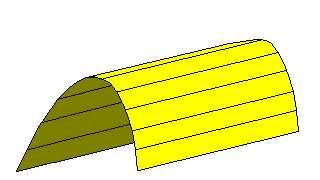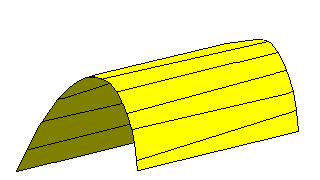Find Axis of a Fold From Limb Intersections
Steven Dutch, Professor Emeritus, Natural and Applied Sciences, University of Wisconsin - Green Bay
Many folds are cylindrical; that is, the rocks have been deformed by simple bending without twisting. The axis, or hinge, of the fold is the line of sharpest curvature of any given layer. Wherever we measure the strike and dip of beds on the fold, we find that the attitudes are always parallel to a common direction, and that direction is also parallel to the axis of the fold.
 |
In the most general sense, a cylinder is defined mathematically as a surface that is generated by a straight line that always moves parallel to itself. The cylinder need not be circular. While folds are usually not perfectly cylindrical, many are sufficiently close to make this a useful approximation. |
Some consequences of cylindrical geometry are:
- The line that generates the cylinder is parallel to the fold axis.
- All planes tangent to the cylinder are tangent along a line parallel to the fold axis.
- All planes tangent to the cylinder are parallel to the fold axis.
- Therefore, any two planes tangent to the cylinder intersect in a line parallel to the fold axis.
- All parallel cross-sections of the cylinder are identical.
- Strike and dip measurements on a cylindrical fold define planes parallel to the fold axis. Any two of these planes intersect in a line parallel to the fold axis.
The last point allows us to find the trend and plunge of a fold axis given two strike and dip measurements. We get best results in the fairly common case of a fold where the limbs or sides of the fold are fairly planar and the hinge is sharply bent. If we project the attitudes of the limbs of the fold, we find they intersect along a line parallel to the fold axis.
 |
Real folds aren't perfectly cylindrical, bedding surfaces are uneven, and strike and dip measurements are often inexact. Thus, if we determine trend and plunge using numerous strike and dip measurements, we will get results with a certain amount of scatter. Spherical projections enable us to deal efficiently with the scatter. |
Example
 |
1. From the strike and dip of the fold limbs, plot the fold axis and find its trend and plunge. 2. Plot structure contours for both limbs. 3. Find the trend and plunge of the intersection. The intersection line is parallel to the fold axis. 4. Using the same trend and plunge, construct the trace of the fold axis. |
 |
1. Structure contours in the vicinity of the fold axis can be constructed by copying the shape of the fold from the map (but see below). 2. If the dip of a significant part of the fold limb is vertical, that will also be the trend of the fold axis (can you see why?) 3. Overturned folds can be handled in the same way as any other fold. 4. If there are several folds together, it may or may not be justified to assume they have the same trend and plunge (see below). |
Additional Comments
1. Although copying the fold shape near the axis is a good way to generate structure contours for the hinge region of the fold, be careful in areas where topography significantly affects outcrop patterns. If topography is a significant factor, use topographic data to construct structure contours around the fold hinge before copying the contours at depth.
2. Since the trend is the strike of a vertical plane containing the fold axis, obviously any vertical plane on the fold will have the same trend as the fold axis. But because folds often have small irregularities, only apply this idea if a fairly large segment of the fold is vertical.
4. In the top illustration, the folds all have nearly the same strike and dip, but with a certain amount of scatter. In such cases, structure contours are probably more accurate if you determine an average trend and plunge and simply copy the shapes of the folds. Being overly literal and extrapolating minor scatter beneath the surface will probably lead to less accurate results, not more.
The bottom illustration suggests that there is a systematic change in fold orientation. In this case, you cannot ignore the changes but should contour each fold separately.
In order to tell whether variations are statistical scatter or real, you may have to examine the data on a larger scale than just the map area.
Return to Course Syllabus
Return to Techniques Manual Index
Return to Professor Dutch's Home Page
Created 17 March 1999, Last Update